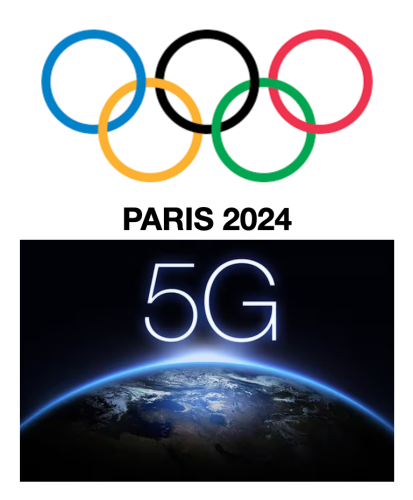
The Paris Olympic Games will showcase not only athletic prowess but also cutting-edge technology as Orange, the French telecom operator, rolls out a private 5G network for the event. This network will be crucial in capturing and broadcasting the opening ceremony and other events in unprecedented ways.
On July 26, the Seine River will host a grand parade of boats carrying athletes from various countries. Spectators will line the riverbanks, while onboard cameras will provide live footage, making viewers feel as though they are right there with the athletes. These cameras, notably, will be smartphones, specifically Samsung S24s, which support advanced video streaming capabilities including HDR.
Three years after a lackluster 5G debut at the Tokyo Olympics, Paris is set to demonstrate the full potential of the technology. Orange has constructed a “private” 5G network along a 6km stretch of the Seine to relay boat footage to the TV production center. This private network is also being deployed at several key venues, including the Stade de France, Arena Bercy, and Paris La Défense Arena.
Private 5G Networks: A Game Changer for Large Events
Private 5G and LTE networks, akin to traditional public cellular networks but managed on-premises by enterprises, are emerging as a primary wide-area LAN solution for countless businesses. According to the Global mobile Suppliers Association (GSA), as of February 2023, there are at least 1077 organizations in 74 countries that have deployed LTE or 5G private cellular networks. These include the National Football League (NFL), which tested private cellular networks during five games in 2022. The success of this trial led the NFL to announce its intention to deploy private cellular network solutions across all 30 NFL stadiums for the 2023 season and beyond.
In the context of the Paris Olympics, traditional broadcast cameras would be impractical for capturing boat footage due to their size, cost, and deployment difficulties. For example, in Marseille, where sailing events will take place, Orange is installing cell antennas on boats to capture the action. During the opening ceremony, around 200 smartphone cameras on boats will connect to Orange’s private 5G network.
Fully Separate Network for Optimal Performance
Orange’s private 5G network is fully separate from its public network. This standalone (SA) 5G network includes a new radio network and a core system that replaces the previous 4G core. Network slicing, a key feature of 5G SA, allows operators to reserve parts of a public network for private use. However, Orange has opted for a completely distinct physical network to ensure high-quality service for both the public and TV broadcasts.
Key advantages of private networks include:
- Low Latency: Private 5G boasts the lowest latency, measured in milliseconds, which is crucial for live broadcasts and real-time data transfer.
- High Capacity: Private networks offer sufficient capacity for uploading ultra-high-definition content to the production center.
- Enhanced Coverage: A single cellular access point in a private network can cover significantly larger areas compared to WiFi access points.
- Scalability: The ability to cover expansive areas with fewer access points makes private networks more economical for large-scale events.
Complementary Role of WiFi and Private Networks
While WiFi remains a crucial tool in the LAN toolkit, private cellular networks and WiFi often complement each other in diverse environments. For instance, in manufacturing facilities, private cellular networks excel in providing guaranteed latency, throughput, and predictability on the factory floor, while WiFi seamlessly connects devices in other areas of the building. The ability of private networks to automatically select the best client for each device and offer inherent security through 3GPP standards and SIM-based security adds a layer of sophistication not easily achieved with WiFi.
Enhanced Public 5G Network for the Olympics
In addition to the private network, Orange is bolstering its public 5G network to handle the immense demands of the Olympics, which includes 878 sports events and 13.5 million ticket holders. About 50 mobile connectivity units have been deployed at major venues, with technology optimized through a mechanism trialed at the Rugby World Cup in France.
Orange is deploying WiFi primarily for media, the organizing committee, and technical staff, rather than for public use, highlighting France’s preference for mobile networks over WiFi for large events.
Strategic Investment in Future Technology
Supporting all these efforts is a robust 60-site Internet Protocol network with a 100 gigabits per second capacity, featuring around 100,000 Internet plugs for various logistical needs and a sprawling WiFi system with 10,000 access points.
Enterprises view private 5G networks as a strategic investment in future technology, leveraging 5G’s capabilities to power innovations across various sectors. Warehouses, factories, ports, and more are already testing private 5G use cases, including HD video surveillance with AI recognition, autonomous mobile robots (AMRs), and predictive equipment maintenance. Private 5G networks allow for controlled and prioritized access, improved battery life, further reach, network slicing, and other benefits that fuel the development of new applications.
The days of proving the value of private cellular networks are behind us. These networks have become the bedrock of secure, efficient, and scalable connectivity, offering undeniable advantages such as reduced latency, improved network management, and enhanced data protection in today’s high-threat landscape. As private networks mature, their role in shaping the future of connectivity becomes increasingly evident, providing enterprises with the tools they need to thrive in the digital age.
As the sole telecom operator for the Paris Olympics, Orange faces a significant responsibility, but the advancements and preparations suggest a promising showcase for 5G technology on a global stage.

